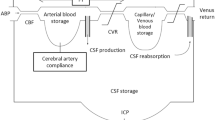Abstract
Anti-G straining manoeuvres, derived from the Valsalva manoeuvre (VM), are physiological methods for protecting fighter pilots against positive accelerations (+Gz). The aim of this study was to investigate the effects of a standard VM on cerebral haemodynamics, in normo- and hypergravity. In six healthy male volunteers, we investigated the cerebral blood flow velocity response induced by a 10-s, 70-hPa (52.5 mmHg) VM, under normogravity, + 2, + 3 and + 4 Gz acceleration plateaus. Mean blood flow velocity (\(\overline {{\text{BFV}}} \)) in middle cerebral artery was monitored by transcranial Doppler velocimetry. In normogravity, no significant variation in \(\overline {{\text{BFV}}} \) was observed at the onset of VM. After a maximal period of 1.2 s, while VM was sustained, \(\overline {{\text{BFV}}} \) decreased significantly (P < 0.05). Following the end of the manoeuvre \(\overline {{\text{BFV}}} \) did not change significantly. When the expiratory pressure had returned to the control value, \(\overline {{\text{BFV}}} \) was transiently increased (P < 0.05) before returning to control values. During hypergravity, \(\overline {{\text{BFV}}} \) was significantly decreased at + 3 and + 4 Gz (P < 0.05) before the onset of VM. While performing VM under + Gz, the main difference compared to the normogravity condition was a significant increase of \(\overline {{\text{BFV}}} \) (P < 0.05) at the onset of the manoeuvre. Our findings would suggest that when performed under + Gz stress, a 70-hPa VM can transiently improve cerebral haemodynamics. However, when VM is sustained for more than 1.2 s it results in a lasting decrease of cerebral perfusion which may lower + Gz tolerance.
Similar content being viewed by others
References
Aaslid R, Lindegaard K, Sorteberg W, Nornes H (1989) Cerebral autoregulation dynamics in humans. Stroke 20:45–52
Bishop C, Powell S, Rutt D, Browse N (1986) Transcranial Doppler measurement of middle cerebral artery blood flow velocity: a validation study. Stroke 17:913–915
Burton R (1988) G-induced loss of consciousness: definition, history, current status. Aviat Space Environ Med 59:2–5
Greenfield J, Rembert J, Tindall G (1984) Transient changes in cerebral vascular resistance during the Valsalva maneuver in man. Stroke 15:76–79
Hamilton W, Woodbury R, Harper H (1936) Physiological relationships between intrathoracic, intraspinal, and arterial pressures. J Am Med Assoc 107:853–856
Howard P, Glaister D (1964) The effects of positive acceleration upon cerebral blood flow. J Physiol (Lond) 171:39P-40P
Jasper H, Cipriani A (1945) Physiological studies on animals subjected to positive G. J Physiol (Lond) 104:6P-7P
Judson W, Hatcher J, Wilkins R (1955) Blood pressure responses to the Valsalva maneuver in cardiac patients with and without congestive failure. Circulation 11:889–899
Klein L, Saltzman H, Heyman A, Sieker H (1964) Syncope induced by the Valsalva maneuver: a study of effects of arterial blood gas tensions, glucose concentration and blood pressure. Am J Med 37:263–268
Markwalder T, Grolimund P, Seiler R, Roth F, Aaslid R (1984) Dependency of blood flow velocity in the middle cerebral artery on end-tidal carbon dioxide partial pressure—a transcranial ultrasound Doppler study. J Cereb Blood Flow Metab 4:368–372
McKenzie I (1991) Noninvasive blood pressure measurement under G. Proceedings of the 28th Annual Symposium SAFE Association, San Antonio, Tex, USA, December 11–13, 1990, 7–11
McPherson R, Koehler R, Traystman R (1988) Effect of jugular venous pressure on cerebral autoregulation in dogs. Am J Physiol 255 H1516-H1524
Meyer J, Handa J, Huber P, Yoshida K (1965) Effect of hypotension on internal and external carotid blood flow. J Neurosurg 23:191–198
Meyer J, Gotoh F, Takagi Y, Kakimi R (1966) Cerebral hemodynamics, blood gases, and electrolytes during breathholding and the Valsalva maneuver. Circulation 33 [Suppl II]:35–48
Miyazaki M (1971) Multiple and simultaneous blood flow measurement by ultrasonic Doppler technique in man, with special reference to the circulatory effect of induced hypertension on internal and external carotid arteries and brachial artery. Jpn Circ J 35:405–412
Miyazaki M (1973) Effect of some respiratory maneuvers on cerebral and peripheral circulation, with special reference to maximum breathing, voluntary hyperventilation and the Valsalva maneuver. Jpn Circ J 37:455–460
Miyazaki M (1978) Circulatory effect of respiratory maneuvers. Angiology 29:541–547
Njemanze P (1993) Perfusion of the visual cortex during pressure breathing at different high-G stress profiles. Aviat Space Environ Med 64:396–400
Ossard G, Clère J, Kerguélen M, Melchior F, Seylaz J (1994) Response of human cerebral blood flow to +Gz accelrations. J Appl Physiol 76:2114–2118
Samnegard H, Tyden G, Thulin L (1980) Internal carotid artery blood flow during the Valsalva manoeuvre in man. Acta Chir Scand 500 [Suppl]:57–59
Sharpey-Schafer E (1965) Effects of respiratory acts on the circulation. In: Hamilton WF, Dow P (eds), Handbook of physiology, section 2: Circulation, vol. 3. Williams and Wilkins, Baltimore, pp 1875–1886
Shubrooks S, Leverett S (1973) Effect of the Valsalva maneuver on tolerance to + Gz acceleration. J Appl Physiol 34:460–466
Symon L, Held K, Dorsch N (1971/72) On the myogenic nature of the autoregulatory mechanism in the cerebral circulation. Cerebral blood flow and intracranial pressure. Proceedings of the 5th International Symposium, Rome-Siena I. Eur Neurol 6:11–18
Tripp L, Chelette T (1991) Cerebral blood flow during + Gz acceleration as measured by transcranial Doppler. J Clin Pharmacol 31:911–914
Wood E, Hallenbeck G (1945) Voluntary (self-protective) maneuvers which can be used to increase man's tolerance to positive acceleration. Fed Proc 4:78–79
Wood E, Lambert E (1952) Some factors which influence the protection afforded by pneumatic anti-G suits. J Aviat Med 23:218–228
Author information
Authors and Affiliations
Additional information
F. Melchior deceased 31 October 1992
Rights and permissions
About this article
Cite this article
Ossard, G., Clère, J.M., Kerguélen, M. et al. Cerebral blood flow velocity response induced by a 70-hPa Valsalva manoeuvre associated with normo-and hypergravity in humans. Eur J Appl Physiol 72, 502–508 (1996). https://doi.org/10.1007/BF00242282
Accepted:
Issue Date:
DOI: https://doi.org/10.1007/BF00242282




